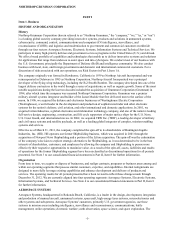Northrop Grumman 2012 Annual Report Download - page 21
Download and view the complete annual report
Please find page 21 of the 2012 Northrop Grumman annual report below. You can navigate through the pages in the report by either clicking on the pages listed below, or by using the keyword search tool below to find specific information within the annual report.
NORTHROP GRUMMAN CORPORATION
-11-
Certain contracts, primarily involving space satellite systems, contain provisions that entitle the customer to recover
fees in the event of partial or complete failure of the system upon launch or subsequent deployment for less than a
specified period of time. Under such terms, we could be required to forfeit fees previously recognized and/or
collected. We have not experienced any material losses in the last decade in connection with such contract
performance incentive provisions. However, if we were to experience launch failures or complete satellite system
failures in the future, for example, such events could have a material adverse effect on our financial position, results
of operations, or cash flows.
Contract cost growth on fixed-price and other contracts that do not result in increased contract value exposes us
to reduced profitability and the potential loss of future business.
Our operating income is adversely affected when we incur certain contract costs or certain increases in contract costs
that cannot be billed to customers. This cost growth can occur if estimates to complete increase or initial estimates
used for calculating the contract cost were incorrect. The cost estimation process requires significant judgment and
expertise. Reasons for cost growth may include unavailability or reduced productivity of labor, the nature and
complexity of the work to be performed, technical or quality issues, the timeliness and availability of materials,
major subcontractor performance and quality of their products, the effect of any delays in performance, availability
and timing of funding from the customer, and natural disasters. Further, items affecting our contract value may
include the inability to recover any claims included in the estimates to complete. A significant change in estimates
on one or more programs could have a material adverse effect on our consolidated financial position, results of
operations, or cash flows.
Our risk varies with the type of contract. Due to their nature, firm fixed-price contracts inherently have more risk
than cost type contracts. In 2012, approximately 44 percent of our annual revenues were derived from fixed-price
contracts. We typically enter into fixed-price contracts where costs can be reasonably estimated based on experience.
In addition, our contracts contain provisions relating to cost controls and audit rights. Should the terms specified in
our contracts not be met, then profitability may be reduced or a loss may be incurred. Fixed-price development work
comprises a small portion of our fixed-price contracts and inherently has more uncertainty as to future events than
production contracts and therefore more variability in estimates of the costs to complete the development stage. As
work progresses through the development stage into production, the risks associated with estimating the total costs
of the contract are generally reduced. While management uses its best judgment to estimate costs associated with
fixed-price development contracts, future events could result in either upward or downward adjustments to those
estimates.
Other contracts are also subject to risk, for example, under a fixed price incentive contract, the allowable costs
incurred by the contractor are paid up to a ceiling, which can affect profitability. Further, under a cost type contract,
the allowable costs incurred by the contractor are also subject to reimbursement plus a fee. We often enter into cost
type contracts for development programs with complex design and technical challenges. These cost type programs
typically have award or incentive fees that are subject to uncertainty and may be earned over extended periods. In
these cases, the associated financial risks are primarily in lower profit rates or program cancellation if cost, schedule,
or technical performance issues arise.
We use estimates when accounting for contracts. Changes in estimates could affect our profitability and our
overall financial position.
When agreeing to contractual terms, we make assumptions and projections about future conditions and events, many
of which extend over long periods. These assumptions and projections assess the cost, productivity and availability
of labor, future levels of business base, complexity of the work to be performed, cost and availability of materials,
impact of potential delays in performance and timing of product deliveries. Contract accounting requires judgment
relative to assessing risks, estimating contract revenues and costs, and making assumptions for schedule and
technical issues. Due to the size and nature of many of our contracts, the estimation of total revenues and costs at
completion is complicated and subject to many variables. Incentives, awards or penalties related to performance on
contracts are considered in estimating revenue and profit rates, and are recorded when there is sufficient information
to assess anticipated performance. Suppliers’ assertions are also assessed and considered in estimating costs and
profit rates.
Because of the significance of the judgment and estimation processes described above, it is possible that materially
different amounts could be obtained if different assumptions were used or if the underlying circumstances were to
change. Changes in underlying assumptions, circumstances or estimates may have a material adverse effect upon the
profitability of one or more of the affected contracts and our performance. See Critical Accounting Policies,
Estimates, and Judgments in Part II, Item 7.
























